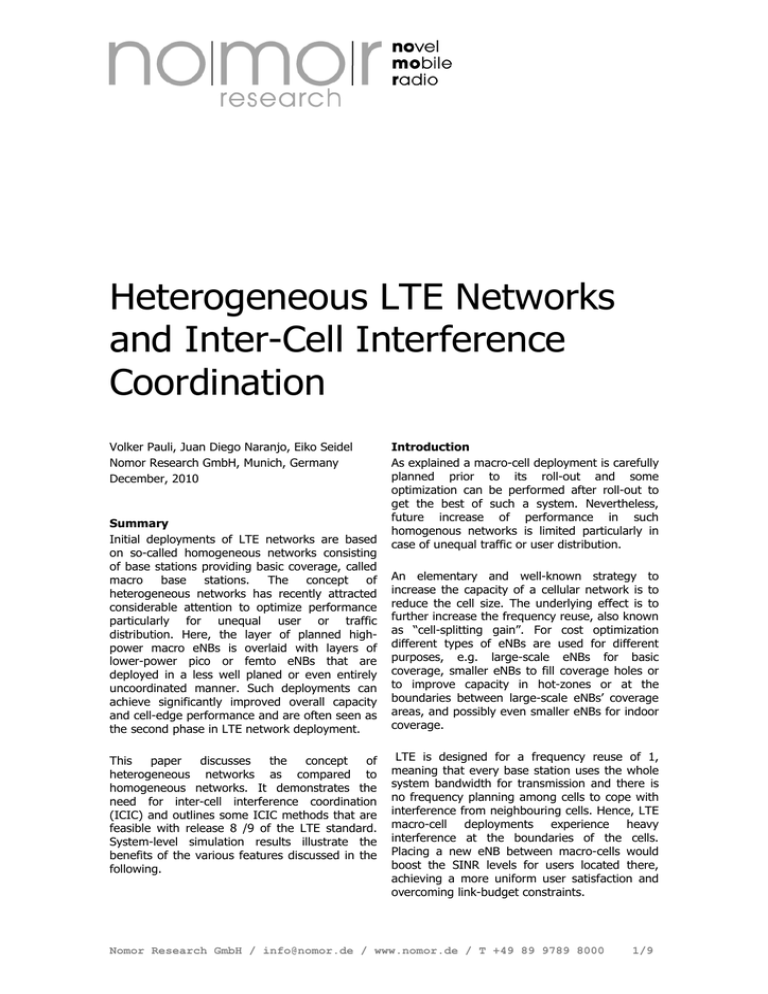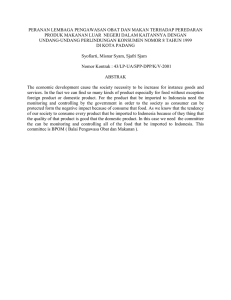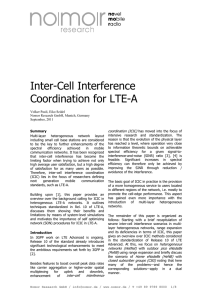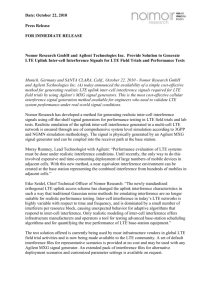Heterogeneous LTE Networks and Inter-Cell
advertisement

Heterogeneous LTE Networks and Inter-Cell Interference Coordination Volker Pauli, Juan Diego Naranjo, Eiko Seidel Nomor Research GmbH, Munich, Germany December, 2010 Summary Initial deployments of LTE networks are based on so-called homogeneous networks consisting of base stations providing basic coverage, called macro base stations. The concept of heterogeneous networks has recently attracted considerable attention to optimize performance particularly for unequal user or traffic distribution. Here, the layer of planned highpower macro eNBs is overlaid with layers of lower-power pico or femto eNBs that are deployed in a less well planed or even entirely uncoordinated manner. Such deployments can achieve significantly improved overall capacity and cell-edge performance and are often seen as the second phase in LTE network deployment. This paper discusses the concept of heterogeneous networks as compared to homogeneous networks. It demonstrates the need for inter-cell interference coordination (ICIC) and outlines some ICIC methods that are feasible with release 8 /9 of the LTE standard. System-level simulation results illustrate the benefits of the various features discussed in the following. Introduction As explained a macro-cell deployment is carefully planned prior to its roll-out and some optimization can be performed after roll-out to get the best of such a system. Nevertheless, future increase of performance in such homogenous networks is limited particularly in case of unequal traffic or user distribution. An elementary and well-known strategy to increase the capacity of a cellular network is to reduce the cell size. The underlying effect is to further increase the frequency reuse, also known as “cell-splitting gain”. For cost optimization different types of eNBs are used for different purposes, e.g. large-scale eNBs for basic coverage, smaller eNBs to fill coverage holes or to improve capacity in hot-zones or at the boundaries between large-scale eNBs’ coverage areas, and possibly even smaller eNBs for indoor coverage. LTE is designed for a frequency reuse of 1, meaning that every base station uses the whole system bandwidth for transmission and there is no frequency planning among cells to cope with interference from neighbouring cells. Hence, LTE macro-cell deployments experience heavy interference at the boundaries of the cells. Placing a new eNB between macro-cells would boost the SINR levels for users located there, achieving a more uniform user satisfaction and overcoming link-budget constraints. Nomor Research GmbH / info@nomor.de / www.nomor.de / T +49 89 9789 8000 1/9 Similarly, the deployment of eNBs inside buildings is a reasonable strategy, as it fills coverage holes that typically occur due to the penetration loss imposed by the walls, while it causes relatively little interference to the macro network for the same reason. Hence, femto-cell deployments are being investigated vigorously in industry and in standardization bodies. Since the backhaul connection of many small size base stations at remote locations can increase operational expenditures significantly, alternative backhaul techniques using the LTE air interface are a hot topic as well. The backhaul connection to the base station, serving as relay node in this case, can be on the same frequency (in-band) or on different frequencies (out-band). In-band relays have been standardised in LTE Release 10 specification while the out-band relays can be used without Release 8/9 specification. Another backhaul alternative is the use of remote radio heads (RRH). Layers of Heterogeneous Networks in LTE In the previously described cases new types of nodes need to be installed in addition to the macro base stations resulting in a so-called “heterogeneous network” (HetNet). The new network elements might be pico- or femto- base stations, Remote Radio Heads (RHH) and/or relays nodes. Figure 1: Heterogeneous multilayer cellular environment In Figure 1, such a multi-layer deployment is illustrated, where a macro-cell deployment is supported by several low-power nodes, all of which solve specific issues as discussed above. Classification into different types of nodes is not always easy, although some function might be specific to different types, e.g. home eNB specific functions summarized in [1]. Base stations of different output power are defined in TS36.104 [5] with the following classification: BS class Wide Area BS Local Area BS Output power per Tx antenna no upper limit < + 24 dBm (1 antenna) < + 21 dBm (2 antennas) < + 18 dBm (4 antennas) Home BS < + 20 dBm (1 antenna) < + 17 dBm (2 antennas) < + 14dBm (4 antennas) The wide area or macro base station does not have a limited output power. The local area base stations or pico base stations on the other hand are fully-featured eNBs with lower transmission power, reduced size and cost that can be deployed easily for improving conditions in coverage holes and providing higher data-rates at cell edge or in hot-spots. The home base station or femto-cell has a limited power that is actually lower than a terminal output power. The restriction is applied to minimize the impact in severe interference conditions from uncoordinated deployment. It is typically operated in a closed mode, meaning that only certain users that are part of a “closed subscriber group” (CSG) are allowed to connect to such an eNB. Interference Scenarios in HetNets Typically, pico-eNBs have a relatively small coverage area due to their low transmit power. If not placed specifically in a hot spot, only a small number of UEs will connect to the pico-eNB which will limit the gain from offloading the traffic from the macro cells. Signalling that supports load balancing between the macro and the pico-eNB has been standardized and is commonly used. This can be achieved by biasing handover decisions between the different eNBs Nomor Research GmbH / info@nomor.de / www.nomor.de / T +49 89 9789 8000 2/9 such that UEs are handed over to pico-eNBs earlier than usual, thus shifting load from the macro-eNB to the pico-eNB. As this corresponds to an expansion of the range of the pico-eNB, this feature is typically referred to as “range expansion”. Similarly cell selection parameters can be adapted for users that are idle. Figure 2 shows an overview of a number of frequency partitioning methods. These ICIC methods describe basic rules on how a system performance boost can be achieved by managing the system bandwidth and transmit power. The following discussion will introduce general notions about frequency partitioning and the available options for LTE release 8/9. Range expansion is not only effective for optimizing the use of resources in the system, but also for reducing the frequency of handovers, hence improving system throughput and user experience [2]. However, with range expansion the UEs handed over to the pico-eNB suffer from lower than usual SINRs, a situation that other techniques like beamforming and power boosting would not be able to completely resolve [2]. So, despite the above benefits this feature presents a challenge to interference management for HetNets, and the deployment of appropriate ICIC algorithms can further boost system performance. Furthermore, when considering CSGs, yet another challenge for interference management arises if UEs are in the coverage area of a homeeNB, typically well shielded from the macro-eNB, but are not allowed access to it. This creates complex high-interference scenarios in both transmission directions that cannot easily be solved. In the downlink such a “macro-UE” is the victim being exposed to heavy interference from the home-eNB, whereas in the uplink the macroUE is the aggressor severely disturbing transmissions to the home-eNB, cf. e.g. [2]. ICIC Methods As motivated in the previous section, Inter-Cell Interference Coordination (ICIC) plays a vital role in heterogeneous networks. ICIC techniques in LTE are mostly limited to the frequency domain, e.g. only partial use of resources in frequency direction and/or adaptation of power levels. Figure 2: Different inter-cell interference coordination schemes Full Frequency Reuse Full Frequency Reuse means that no frequency partitioning is performed between eNBs of the same network. eNBs in this configuration transmit with uniform power over the entire system bandwidth. This is the conventional way of operating an LTE network. The main pitfall to this configuration is that cell-edge users experience heavy interference from neighbouring cells in the downlink and create heavy interference in the uplink, greatly degrading their communication performance. Hard Frequency Reuse This ICIC method is typically seen in GSM networks, when it comes to distribution of frequencies among the cells. When applied to LTE it means that the sub-carriers are divided into 3, 4 or 7 disjoint sets. These sets of subcarriers are assigned to the individual eNBs in such a way that neighbouring cells don't use the same set of frequencies. This reduces the interference at the cell edge of any pair of cells Nomor Research GmbH / info@nomor.de / www.nomor.de / T +49 89 9789 8000 3/9 significantly and can be considered the opposite extreme to Full Frequency Reuse in matters of frequency partitioning techniques. While user interference at cell edge is maximally reduced, the spectrum efficiency drops by a factor equal to the reuse factor. SINR levels for cell-edge UEs in the hightransmit power regions, and the other regions still have suitable SINR levels for cell-center UEs, as it is depicted in Figure 3. It can nicely be seen that the high power region serves a larger coverage area. This scheme is particularly useful for ICIC in the downlink. Fractional Frequency Reuse This is a hybrid frequency partitioning combining the concepts of the two previous schemes. It consists of dividing the spectrum into two parts which will have different frequency reuse. One section of the system spectrum is used in all cells, while the other part of the spectrum is divided among different eNBs as in hard frequency reuse. The idea is that the eNB would assign the fully-reused frequency chunks to center-cell UEs and the other chunks to the celledge UEs. This scheme is particularly useful for ICIC in the uplink, where severe interference situations can occur where the user is located close to a strong interferer in the neighbor cell. Soft Frequency Reuse In this frequency partitioning method an eNB transmits in the whole system bandwidth, but using a non-uniform power spectrum. Figure 2 (bottom) illustrates power spectrum assignments in the different cells of a system with Soft Frequency Reuse and reuse 3. It can be noticed that in the spectrum there is a region of high-power transmissions and some regions of low-power transmissions. Using a similar strategy as the previous method, resources in the high-power region are preferably assigned to UEs located at the cell edge, while cell-center UEs are typically assigned resources in the lowpower regions.1 This coordination scheme leads to improved 1 Note, however that UEs can only be assigned to either of the regions and reassignments require RRC signaling. Figure 3: SINR strength distribution over the cell with soft frequency partitioning. Note that in the case of HetNets it may also be useful to block some of the resources available in frequency direction entirely at the pico or femto eNBs but let the macro eNB use the entire spectrum. It grants resources to the macro cells that are not interfered by the smaller eNBs, but comes at the price of reduced throughput for the small eNBs. It does not necessarily result in a reduced user throughput since the number of UEs connected to the small eNBs is usually limited. X2 Signalling to support ICIC The already discussed partitioning schemes can in principle be easily implemented in the radio resource management (RRM) of the eNB. They can be configured statically and run without interaction between different eNBs. However, better performance can be achieved if the above schemes are configured dynamically, based on Nomor Research GmbH / info@nomor.de / www.nomor.de / T +49 89 9789 8000 4/9 active information exchange between eNBs in order to better adapt to the current state of the network. X2 signalling provides the mechanisms for the exchange of this information, cf. [3] and references therein. Note that the signalling and its information elements are well defined in 3GPP specifications, but the specific reaction of an eNB in response to the reception of such a message is not. Hence, in a multi-vendor network, there is no guaranteed reaction of an eNB to an incoming ICIC-related message from another eNB. The following sections describe a set of X2 messages meant for ICIC in Release 8/9. Relative Narrowband Transmit Power Indicator, RNTP This information message is sent to neighbour eNBs. It contains 1 bit per physical resource block (PRB) in the downlink, indicating if the transmission power on that PRB will be greater than a given threshold. Thus, neighbour eNBs can anticipate which bands would suffer more severe interference and take the right scheduling decisions immediately rather than relying on the UEs' CQI reports only. sent out proactively by eNBs, this indicator is only triggered when high-interference in the uplink direction is detected by an eNB. The overload indication will be sent to neighbour eNBs whose UEs are potentially the source of this high interference. The message contains a low, medium or high interference level indication per PRB. The question, which cell is responsible for the high interference is of course not a trivial one. It can be seen that specifications for Release 8/9 were defined having mostly homogeneous macro-cell deployments in mind. It provides only relatively simple means for ICIC and fails for instance to address mechanisms to improve inter-cell interference on control channels, e.g. PDCCH, PHICH and PCFICH. This limits for example the aggressiveness in which range expansion can be configured and hence the gains that can be achieved using HetNets with range expansion. Release 10 will enhance the X2 signalling in order to support more sophisticated ICIC algorithms, involving interference coordination among eNBs in time domain [6]. Nomor Research will report in one of its next newsletter about progress in 3GPP standardisation. High Interference Indicator, HII This indicator for uplink transmissions works similarly to the previous RNTP message for the downlink. There is one bit per PRB indicating if neighbouring eNBs should expect high interference power in the near future. Hence, typically only PRBs assigned to cell-edge UEs are indicated. RSRP measurements as part of handover measurement reports can identify celledge UEs. In a similar way this indicator can be used to identify the bands used in a frequency partitioning scheme. Simulation Results In this section, we present some system-level simulation results to illustrate the effects of the various features described above. For this purpose 3 scenarios are evaluated. The first scenario corresponds to a macro-cell deployment. The second scenario adds a layer of pico-eNBs on top of the macro-cell deployment. The third scenario includes Range Expansion, additionally to the HetNet layout. Range expansion is achieved by setting the handover biases between pico-eNBs and macro-eNBs to 4 dB. Interference Overload Indicator, OI While the previously described X2 messages are These scenarios are configured according to the guidelines for Case 1 described in the 3GPP Nomor Research GmbH / info@nomor.de / www.nomor.de / T +49 89 9789 8000 5/9 technical reports for simulation of HetNets [4]. In summary, the simulations are fully dynamic with full RRM functionality such as scheduling (simple proportional fair strategy in this case), link adaptation, hybrid ARQ, etc. Furthermore, the users are moving with 3km/h, and they carry out handovers at the cell boundaries as specified in 3GPP (handover margin/hysteresis is set to 3dB). 30 UEs are dropped per macro-cell area according to configuration 4a, where 2 UE clusters consisting of 2 UEs each are located in each macro-cell and a pico-eNB is placed in the middle of every UE cluster. The remaining UEs are dropped uniformly in the macro-cell area. Figure 4 illustrates an example of such a deployment. second improvement in throughput is achieved when range expansion (RE) is used. By the handover of macro-UEs to pico-eNBs traffic is offloaded from the macro-cell layer to a number of pico-eNBs. From Figure 6 it can be concluded that the introduction of RE in the system lowers the effective SINRs. Figure 5: PDCP Throughput, Configuration 4a with 2 UE clusters per macro Figure 4: Cell layout for configuration 4a and 2 pico-eNBs per macro-cell scenario. Figure 5 and 6 show the CDFs of PDCP throughput and Effective SINR results obtained in this scenario, respectively. The first observation is the improvement of throughput achieved by the introduction of a pico-cell layer to the macro-layer scenario. A Figure 6: Effective SINR CDF, configuration 4a with 2 UE clusters per macro. This happens because of the high interference experienced by UEs in the extended pico-cell area. This is however more than compensated by the fact that the UEs connected to the picoeNBs get significantly more resource than when Nomor Research GmbH / info@nomor.de / www.nomor.de / T +49 89 9789 8000 6/9 connected to the macro-eNB due to a lower load. Furthermore, we evaluated a simple static ICIC scheme for downlink. Here, frequencypartitioning is performed in a way that macroeNBs transmit in the full frequency spectrum (50 PRBs) while pico-eNBs transmit in a reduced band (30 PRBs), which means that the pico-eNB is not generating interference in the remaining unused downlink resources. Hence a frequency selective scheduler at the macro-eNB, after evaluating the measurement reports, would take advantage of this effect. The macro-eNB would assign the low-interference frequency segments to macro-UEs located close to the pico-cells, protecting these macro-UEs from the interference from the respective pico-eNB. In this scenario it can be observed that no significant variation is experienced at the PDCP throughput CDF, although a slight increase in the SINR is seen, indicating a trade off between resources and transmission power that renders in same throughput performance for pico-cell UEs. Figure 7 shows the TPs for the RE scenario with and without this ICIC strategy. ICIC technique is that the optimal configuration depends very much on the specific scenario, i.e. the location of the pico-eNB in the macro-cell and on the distribution of UEs and the traffic in the vicinity of the pico-eNB. A semi-static approach continuously adapting the frequency partitioning on a slow basis provides further potential for performance enhancements. Configuration 4b [4] with 2 pico-eNBs was also simulated under the same RE+ICIC scenario. The basic difference between configuration 4a and 4b is the dropping of UEs. In Configuration 4b 10 UEs are dropped per UE cluster, but the total number of UEs is still set to 30 per macrocell. Figure 8 shows an example of such a scenario, where the higher density of UEs around pico-eNBs is visible compared to configuration 4a in Figure 4. Figure 8: Cell layout for configuration 4b and 2 pico-eNBs per macro-cell scenario. Figure 7: PDCP Comparing effects on TP due to ICIC strategy, configuration 4a. It can be concluded that severe interference impact from pico- or femto-cells onto the macrocells in HetNet deployments could be resolved using this technique. A problem with this static Figure 9 shows the results for this configuration. In this case, the number of UEs connected to the pico-eNBs and hence the offloading gain from introducing pico-eNBs is already very significant. Expanding the range of the pico-eNBs actually degrades the performance as the pico-eNBs Nomor Research GmbH / info@nomor.de / www.nomor.de / T +49 89 9789 8000 7/9 become overloaded. Similarly, using statically configured ICIC as described above will further reduce the resources available for the pico-UEs leading to overall performance degradation. Here, a dual ICIC scheme, leaving some resources to the pico-UEs only would be more beneficial. in an upcoming Research. newsletter from Nomor References [1] Nomor Newsletter, “LTE Home Node Bs and its enhancements in Release 9”. [2] R1-100700, Interference conditions in Heterogeneous Networks. 3GPP TSG RAN 1 meeting #59 bis. [3] TS 36.420, E-UTRAN; X2 General Aspects and Principles; Release 9, December 2009. [4] TS 36.814, E-UTRAN; Further advancements for E-UTRA physical layer aspects; Release 9, March 2010. [5] TS 36.104 E-UTRA; Base Station (BS) radio transmission and reception; Release 9, Oct 2010 Figure 9: Comparing effects on TP due to ICIC strategy, configuration 4b. So again, it becomes clear that both range expansion and ICIC must be configured dynamically depending on the scenario to achieve best performance. Conclusions Heterogeneous Networks constitute a promising concept to improve system performance, to mitigate coverage holes, to provide a uniform user experience over the entire cell area and last but not least to satisfy high traffic demands in hot-zones. Properly configured range expansion has the potential to increase the gains as it leads to better load balancing over the different network layers. The applicability of range expansion is, however, limited by inter-cell interference calling for advanced ICIC methods. Unfortunately, support of ICIC is limited to data channels in LTE release 8 / 9. Further enhancements of ICIC support particularly for control channels are in the process of standardisation and will be included in Release 10 specification. A related report will be provided [6] RP-101229 RAN2 CRs on Core part: Enhanced ICIC for non-CA based deployments of heterogeneous networks for LTE RAN2; 3GPP TSG RAN meeting #50 LTE Discussion Forum http://www.linkedin.com/groups?gid=1180727 Note: This white paper is provided to you by Nomor Research GmbH. Similar documents can be obtained from www.nomor.de. Feel free to forward this issue in electronic format. Please contact us in case you are interested in collaboration on related subjects. Disclaimer: This information, partly obtained from official 3GPP meeting reports, is assumed to be reliable, but does not necessarily reflect the view of Nomor Research GmbH. The report is provided for informational purpose only. We do not accept any responsibility for the content of this newsletter. Nomor Research GmbH has no obligation to update, modify or amend or to otherwise notify the reader thereof in the event that any matter stated herein, or any opinion, projection, forecast or estimate set forth herein, changes or subsequently becomes inaccurate. Nomor Research GmbH / info@nomor.de / www.nomor.de / T +49 89 9789 8000 8/9 System Level Simulation Services Nomor Research has developed a comprehensive simulation environment with fully compliance to standards such as LTE, LTE Advanced and HSPA and offers related services to support research, development and standardisation. Features of the dynamic multi-cell, multi-user system level simulator include: • macro-cell and HetNet deployments (pico-, femto-cell, relay nodes) • flexible base station and user configurations and drop models • different transmitter and receiver chains incl. MIMO, ZF, MMSE • channel modeling with slow/fast fading, pathloss, full user mobility • intra- and intercell interference modeling for OFDMA, SC-FDMA and WCDMA • simultaneous up- and downlink simulation • 2D and 3D antenna pattern & beam forming • Extensive metrics and KPIs: capacity, throughput, spectral efficiency, user QoS etc • High-speed processing close to real-time using multi-core & graphic card processors The simulator can be used on project basis or in customized simulation campaigns. The performance of the system level simulator has been calibrated to simulation results obtained in standardisation. Research on advanced algorithms include, but are not limited to: • advanced features as link adaptation, HARQ, power control, measurements • scheduling and resource allocation algorithms considering channel and buffer status, QoS etc. • inter-cell interference coordination, avoidance and cancellation • single user-, multi-user MIMO with open and closed loop feedback • cooperative multi-point transmission and reception • functions for self-organising and selfoptimizing networks (e.g. load balancing, mobility optimization, tilt optimisation, range extension, power saving etc. ) • radio resource management for heterogeneous networks If you are interested in our services please contact us at info@nomor.de or visit us at http://www.nomor-research.com/simulation Nomor Research GmbH / info@nomor.de / www.nomor.de / T +49 89 9789 8000 9/9



